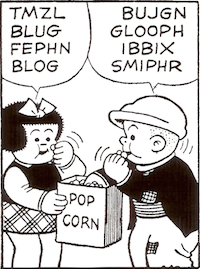My friend the dictionary has let me know not only that I've misunderstood the word nonplussed but that everyone around me misunderstands it too.
I've taken nonplussed to mean "not bothered," "unfazed," as did a colleague in a brief exchange about my son the college student:
"It's a lot more work than high school was."Please imagine my rejoinder as Larry David might deliver it, for this conversation is as close as I've ever come to having life imitate Curb Your Enthusiasm.
"Well, I'm sure he's nonplussed about it."
"Oh, he's plussed. He's a little plussed."
Plussed, at least as I was using it, is not a word (as I suspected, and my son wasn't fazed anyway). Nonplussed of course means the opposite of what my colleague and I thought it meant. From the Oxford English Dictionary:
nonplus, v. trans.The words go back to the Latin non plus, meaning "not more," "no further." An OED sample sentence, from Josephine Tey's novel The Franchise Affair (1949): "Now, seeing the actual physical Betty Kane again, he was nonplussed."
To bring to a nonplus or standstill; to perplex, confound. Freq. in pa[st]. p[artci]ple. (cf. NONPLUSSED adj.).
nonplussed, adj.
Brought to a nonplus or standstill; at a nonplus; perplexed, confounded.
Realizing my mistake about the word nonplussed left me nonplussed, but only briefly. It was probably a lot worse for the guy who saw Miss Kane, actual, physical, again.
[Faze: A word that looks as though it must be misspelled, no? I always reassure my students that, yes, it's legit.]















